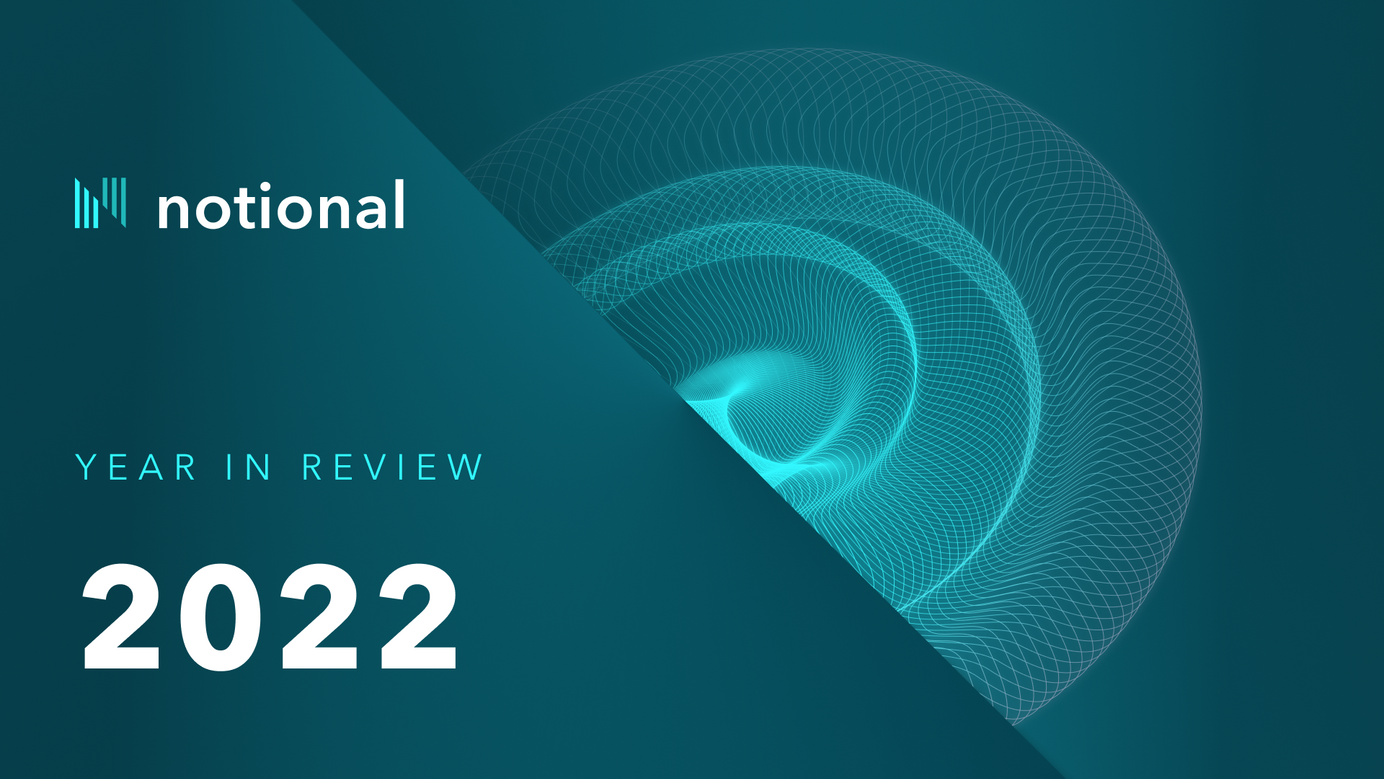
Year in Review: 2022
2022 has been a challenging year for all of crypto, but it has also been highly productive for Notional. Notional saw its TVL and usage metrics draw down dramatically over the course of the year in line with the broader DeFi market.
But despite the obvious obstacles, this year reinforced the need for what Notional is building - secure, transparent, on-chain lending markets. I’m more excited than ever to execute on Notional’s mission and I’m optimistic that we will take the lessons of 2022 and apply them in 2023 to great success.
Goals for 2023
We believe that 2023 will be a strong year for Notional and that the protocol will be able to achieve strong organic growth and economic sustainability by the end of the year.
To these ends, we are setting the following goals for 2023.
- Increase outstanding debt from $21M to $150M. Increase protocol fee revenue to $1.35M per year.
- Increase organic LP returns and decrease NOTE liquidity incentive emissions by 70% to 3.9M NOTE per year.
With the products that we have already shipped and the features that are currently in development, we believe we’re on the right track to hitting these targets and setting Notional up for strong, organic growth in 2023.
Achievements
Notional accomplished a lot in 2022. In its first year in operation, Notional V2 achieved ~$660M in total loan volume, attracted as much as $975M in TVL at its peak, and established itself as the leading fixed rate lending protocol by a wide margin. We lost most of that TVL over the course of the year, but proved that Notional V2 works well and that the protocol is secure and safe for large, risk-averse lenders, even in times of extreme volatility.
From a development standpoint Notional launched two major products - the NOTE staking module and the initial Balancer/Aura leveraged vault. The NOTE staking module has facilitated 345.5 ETH in reinvestments, sustainably incentivized NOTE liquidity, and provided $2.3M in insurance capital for Notional users. Leveraged vaults have recently launched in beta and have contributed ~$3M to outstanding debt so far and will be an increasingly large part of Notional’s overall outstanding debt going forward.
Challenges
2022 exposed two main areas that Notional needs to improve upon to achieve lasting success.
- Generating borrow demand. Many users value fixed borrowing rates - but so far, fixed rate borrowing on Notional has a lot of drawbacks relative to borrowing on other platforms. The fixed rate borrowing UX is more complicated, the rates are higher, and fixed term loans are less flexible than variable rate, open term loans. These drawbacks have deterred a lot of users and hindered Notional’s growth.
- Increasing organic LP returns. Notional relies on LPs to provide liquidity to Notional’s markets and make it possible for users to lend and borrow. Without LPs, no one can use Notional. To date, Notional has relied heavily on NOTE incentives in order to attract and retain LP capital because organic LP returns have been poor. This is unsustainable. Increasing organic LP returns is necessary for Notional to achieve protocol sustainability and strong organic growth over the long term.
These challenges are not new, and the Notional core team has been working on solutions to them for months already. We expect that further leveraged vault development and increased variable rate yields on Notional will drive substantial progress toward overcoming these challenges in 2023.
Financials
Notional is in a strong financial position. Even with zero revenue growth, the protocol can continue to operate and invest in product development at our current pace for 2.5 - 3 years. Here is a full breakout of the numbers.
NB - Notional currently uses COMP incentive revenue to fund NOTE reinvestments/rewards for NOTE stakers.
Cash on hand: $5M
Current annual expense (headcount and operations): $1.7M
Current annual expense (security audits): $300k
Current annual revenue (fees): $200k
Current annual revenue (COMP incentives): $388k
Understanding Notional’s revenue
Notional currently earns revenue from two sources - transaction fees and COMP incentives. COMP incentive revenue derives from Notional’s integration with Compound. Notional’s COMP incentive revenue is equal to the protocol’s TVL * the COMP incentive yield for suppliers on Compound.
The incentive revenue that Notional earns is temporary. We don’t know how long the COMP incentives will last. However, it should be noted that if Notional were to switch its Compound integration for Euler we could ~3x our incentive revenue for the same amount of TVL because of Euler’s larger EUL incentive yield.
Notional’s long-term revenue source is transaction fees. Anytime a user lends or borrows, Notional earns a 0.25% pro-rata fee. The fee is prorated by time to maturity - for a 1 year loan, Notional earns 0.25% of the loan amount, for a 6-month loan Notional will earn 0.125%, etc.
The most useful way to measure and project Notional’s transaction volume and fee generation is outstanding debt. Borrowers create opportunities for lenders and arbitrageurs, and these opportunities drive transactions and fee generation. Historically, Notional has generated annualized fee revenue equivalent to ~0.9% of outstanding debt. Roughly speaking, $100M in outstanding debt will generate $900k in fees for Notional over the course of a year.
Growing outstanding debt
Leveraged vaults and new currency listings will be key drivers of growth in Notional’s outstanding debt. We expect growth in outstanding debt to primarily come from two buckets - ETH and ETH staking derivatives, and stablecoins. We plan to expand our currency listings significantly in the first half of next year to include all major ETH staking derivatives and leading stablecoins.
New asset listings and new leveraged vaults will generate borrowing demand for new currencies as well as create opportunities for interest rate arbitrage between similar assets on Notional. We believe that it is realistic and achievable to aim for $75M in outstanding debt among ETH and ETH staking derivatives, and $75M in outstanding debt among stablecoins by the end of next year.
Increasing organic LP returns
Removing the protocol’s dependence on NOTE incentives requires making providing liquidity sufficiently profitable on its own without additional incentivization. Our strategy for increasing organic LP returns relies on three points - leveraged vaults, expansion of our base money market integration beyond Compound, and changes to our liquidity curve that will 2x LP efficiency.
Executing on these three points will allow us to cut NOTE incentives significantly by increasing organic returns and reducing the amount of liquidity the protocol needs. Leveraged vaults increase LP utilization and the rates at which LPs lend. Moving money off Compound will allow Notional LPs to earn higher rates on unutilized capital. And a new liquidity curve that improves efficiency will increase LP utilization and decrease the amount of liquidity Notional needs to operate.
Taken together, we believe that this strategy will bring organic LP returns up to market-leading rates and allow us to use NOTE incentives as a small added bonus as opposed to the majority of the incentive for users to provide liquidity.
Summary
2022 had its ups and downs but it has proven the need for and importance of what we’re building at Notional. The protocol has had its challenges but I believe that we have put together the right plan to meet those challenges and have the resources that we need to execute on that plan. I look forward to a breakout year for Notional in 2023.
Teddy
Notional Finance Newsletter
Join the newsletter to receive the latest updates in your inbox.







